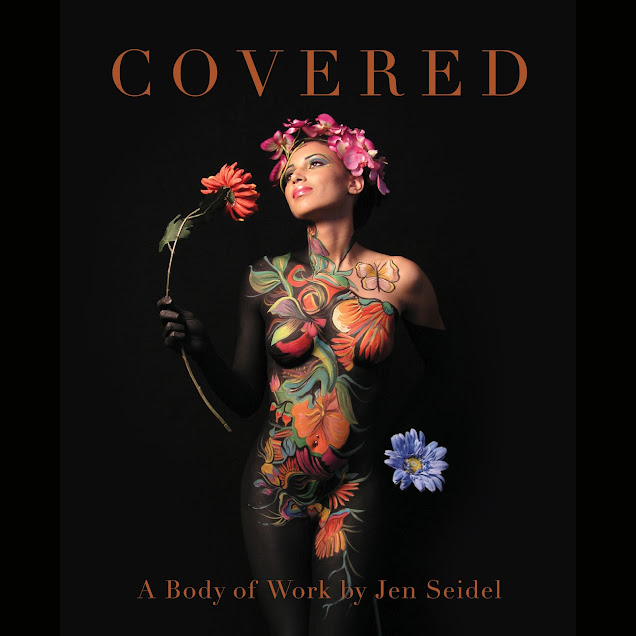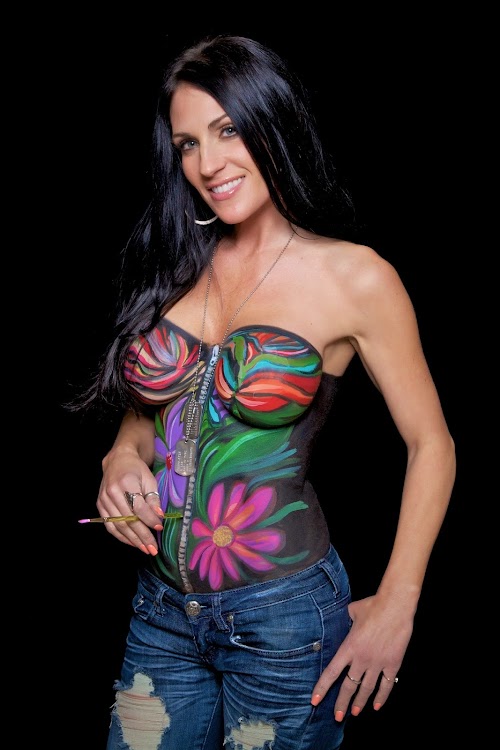5 Questions for Jen Seidel
We have with us today Jen Seidel (website | facebook | Twitter), a body paint artist who has created an amazing body of work seen at events, commercials on the web, TV and print.
Many of her body paints are so real they will leave you surprised or do a double take.
She's now coming up with a coffee table book collecting the art images of models from events and photo shoots she has worked on.
Her book COVERED, A Body of Work by Jen Seidel is now on Kickstarter and you can back it before 21 Dec 2013.
Check out more art and her book at https://kck.st/18Qi3dP

Qn1: You started out by helping out at your family's cosmetics business. How did you get into body painting and what's your motivation for this career transition?
Body painting wasn’t really a career transition for me. It is an added specialty to my present makeup services that I now offer and love.
Body painting was a fluke. Being that I am an artist and Halloween is my favorite day of the year, I decided to paint myself as a cheetah which is how it all began. I wanted to be different and unique and I spent 10 hours painting myself with help from my mother, adding hair extensions with help from my daughters, and had a great time presenting myself to public. I spent hours stopping and posing for pictures every 5th step and people had no clue who I was. People were talking about the painted Cheetah months later. I decided that if it got that much attention how I could make it work and create business from it.
My story is told in the beginning of the book about how that evening ended up and after, to where it has evolved to today.
Qn2. Can you share with us some interesting stories or memorable experiences while body painting?
Being a body painter, definitely brings for some very memorable stories.
I think the most memorable and nerve racking was when my models would get lightheaded and almost pass out right there while I was painting them.
I could not understand why this was happening so frequently and finally after about 1 year, realized it was because they were holding their breath while they were being painted. They were scared to talk and therefor breathe normal as I painted them, in fear of me messing up the design and my painting flow.
Many designs I paint are very detailed and not so easy to paint but when I realize this was the case, I quickly fixed the issue. I explained that holding their breath or not talking caused them to get dizzy and therefore see spots and black out. For a while I thought it was the girls not getting their proper nutrition, but as time went on I realized that it was a combination of the lack of oxygen and locking their knees for long periods of time.
In many instances we had to stand for hours on end, and as you can imagine, not an easy task. Once we realized it, the issue was quickly resolved.

Qn3. What tools and paint do you use for body painting? What happens if the models sweat? Or how do they clean off the paint?
I use water based paints and paint brushes. I do not use airbrushes or any other tools. I cut my own stencils when I need to for specific logos.
Because the paints I use are water based, they wash off with soap and water. There are many types of water based paints for face painting and the body. I do not use just one product but several depending on the job.
Being that I paint myself on occasion I am very knowledgeable and familiar with the products before I use them on others. I personally do not use anything that will not wash off the human body easily because as a licensed Aesthetician of the state of Maryland I find it can be harmful to the skin and cause break outs, skin disorders or rashes.
I do not work with alcohol based mediums or latex of any kind as these are the ones that are difficult to remove.
If a model perspires the paint is not guaranteed to stay on. I will sometimes spray them with a fixative to help it last a little longer. I can, for a special request use temporary paints that do not wash off right away but I take great caution and explain to the models or client, the process and what to expect. There is usually an additional fee that goes along with this type of painting.
I do not use materials on the models or clients I work with that is harmful to them or their skin. As I mentioned earlier, if I cannot use it on myself, I will not use it on others.

Jen Seidel - self painting
Qn4. What are the challenges of body painting?
There are always challenges in any business you are in and one in particular for me has always been, time. There is never enough time to paint everything perfectly the way you want as an artist. Artists need time.
Walking away from a design knowing you want to spend another 2 hours on it but cannot, is my biggest challenge.
I have had to learn over the years what I can and cannot do. I cannot stand to disappoint others.
The pressure of getting a company logo done in a reasonable time period and depending on a model to show up at the time you need her to show up, can also most definitely be challenging.
Team work is a huge part of the body painting business and trusting your team is crucial. I try to maintain good communication with my models and clients, and I try to make it clear what to expect before they come to a job or a session.
I do not build the picture to be an easy time for anyone and we work together to make it happen as smoothly as we can. If they have been working with me for a while they are aware of how stressful a job can be compared to a fun easy day if not on time. Every minute counts when painting and practice makes perfect. I believe that I am more comfortable judging the time I need for each design as its been 8 years of practice as a body painter. So it is much easier than it used to be.
Finding my models has never been difficult. Once they see my work, they are excited to be a part of it.

Qn5. You mentioned on your Kickstarter page that the book includes stories of your struggle of fighting for your art to be accepted. Can you tell us briefly about the struggle and what you learned?
Being a body painter to me is still being an artist in every way.
The majority of the people in the beginning heard the words “body painting” and automatically are trained to think of nudity, naked people and taboo. From the beginning, I viewed body painting as a way of art expression. I believed that I could eventually get everyone’s attention to see my artistic skills first, not the nudity.
Once I started painting people, I realized I could actually trick people into thinking it was really clothing while marketing at the same time. They were noticing the art on a model first thinking they were dressed, yet it was my painted design.
Many at first could not understand why I was doing what I was doing. But as I continued they started to realize. Eventually the art evolved and beautiful photos were taken at each event which made great images for marketing of their company or concept.
As the years went by I kept a collection of work with so many talented photographers, beautiful models and great charities I have had the honors of working with over the years which are now part of my first book COVERED, A Body of Work by Jen Seidel.


Check out Jen Seidel's Kickstarter project for her book at https://kck.st/18Qi3dP




Add new comment